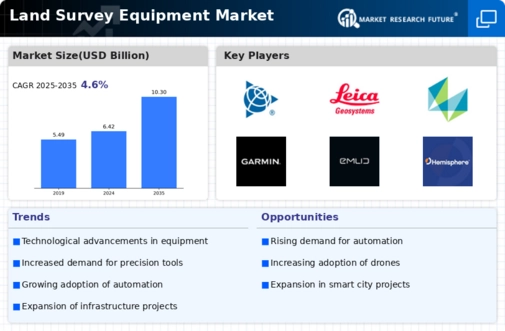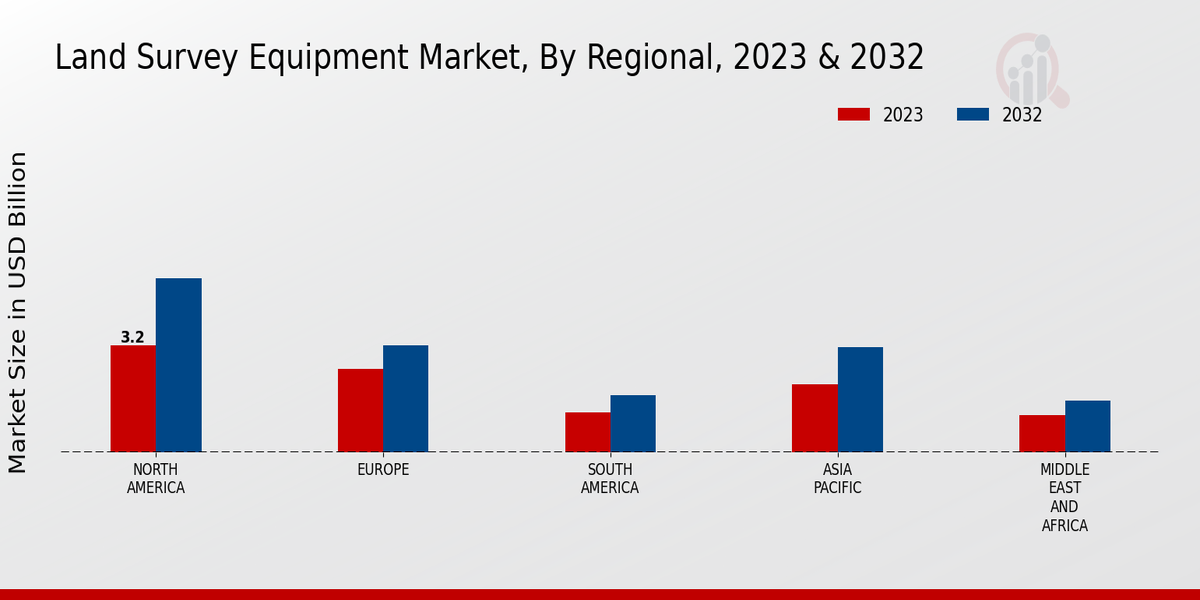Environmental Regulations
Increasing environmental regulations are shaping the Global Land Survey Equipment Market Industry. As governments implement stricter environmental policies, the need for accurate land surveying becomes paramount. Surveying equipment is essential for assessing land use, environmental impact, and compliance with zoning laws. For instance, in the United States, the Environmental Protection Agency mandates thorough land assessments before any development project. This regulatory landscape drives demand for advanced surveying tools that can provide detailed and reliable data. Consequently, the market is likely to expand as companies seek to adhere to these regulations while minimizing environmental footprints.
Market Growth Projections
The Global Land Survey Equipment Market Industry is poised for substantial growth, with projections indicating a market size of 6.42 USD Billion in 2024 and an anticipated increase to 10.3 USD Billion by 2035. This growth trajectory suggests a robust demand for land surveying equipment driven by various factors, including technological advancements and infrastructure development. The compound annual growth rate (CAGR) of 4.38% from 2025 to 2035 reflects the industry's resilience and adaptability to changing market dynamics. Such projections underscore the importance of continuous innovation and investment in the sector to meet the evolving needs of consumers and industries.
Infrastructure Development
Infrastructure development is a critical driver for the Global Land Survey Equipment Market Industry. Governments worldwide are investing heavily in infrastructure projects, including roads, bridges, and urban development. This trend is particularly evident in emerging economies, where urbanization is accelerating. For example, in regions like Asia-Pacific, the demand for land surveying equipment is expected to rise as countries undertake large-scale infrastructure initiatives. The market is anticipated to grow at a CAGR of 4.38% from 2025 to 2035, potentially reaching 10.3 USD Billion by 2035. Such investments necessitate precise surveying to ensure compliance with regulations and project specifications.
Technological Advancements
The Global Land Survey Equipment Market Industry is experiencing a surge in demand due to rapid technological advancements. Innovations such as 3D laser scanning, drone surveying, and GPS technology are transforming traditional surveying methods. For instance, the integration of drones allows for more efficient data collection over large areas, significantly reducing time and labor costs. As a result, the market is projected to reach 6.42 USD Billion in 2024, reflecting a growing reliance on advanced equipment. These technologies not only enhance accuracy but also improve safety in surveying operations, making them indispensable in various sectors including construction and urban planning.
Growing Demand for GIS Solutions
The growing demand for Geographic Information Systems (GIS) is influencing the Global Land Survey Equipment Market Industry. GIS technology enables the analysis and visualization of spatial data, which is crucial for urban planning, resource management, and disaster response. As organizations increasingly rely on GIS for decision-making, the need for compatible surveying equipment rises. This trend is particularly pronounced in sectors such as agriculture, where precision farming techniques are gaining traction. The integration of GIS with land surveying tools enhances data accuracy and operational efficiency, thereby propelling market growth. The synergy between these technologies is expected to drive further innovations in the industry.
Market Trends and Consumer Preferences
Market trends and evolving consumer preferences are pivotal in shaping the Global Land Survey Equipment Market Industry. As industries adopt more sustainable practices, there is a growing preference for eco-friendly surveying equipment. Consumers are increasingly seeking tools that not only meet performance standards but also align with environmental sustainability goals. This shift is prompting manufacturers to innovate and develop greener technologies, such as solar-powered surveying devices. The market's responsiveness to these trends indicates a potential for growth as companies adapt to changing consumer demands. This adaptability may enhance market resilience and foster long-term sustainability.















